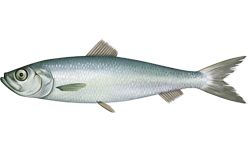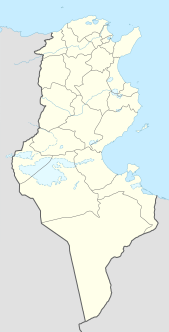Year 256 BC was a year of the pre-Julian Roman calendar. At the time it was known as the Year of the Consulship of Longus and Caedicius/Regulus. The denomination 256 BC for this year has been used since the early medieval period, when the Anno Domini calendar era became the prevalent method in Europe for naming years.

Clupeidae is a family of ray-finned fishes, comprising, for instance, the herrings, shads, sardines, hilsa, and menhadens. The clupeoids include many of the most important food fishes in the world, and are also commonly caught for production of fish oil and fish meal. Many members of the family have a body protected with shiny cycloid scales, a single dorsal fin, with a fusiform body for quick, evasive swimming and pursuit of prey composed of small planktonic animals. Due to their small size, and position in the lower trophic level of many marine food webs, the levels of methylmercury they bioaccumulate are very low, reducing the risk of mercury poisoning when consumed.

Herring are forage fish, mostly belonging to the family Clupeidae.

Atlantic herring is a herring in the family Clupeidae. It is one of the most abundant fish species in the world. Atlantic herrings can be found on both sides of the Atlantic Ocean, congregating in large schools. They can grow up to 45 centimetres (18 in) in length and weigh up to 1.1 kilograms (2.4 lb). They feed on copepods, krill and small fish, while their natural predators are seals, whales, cod and other larger fish.

Sprat is the common name applied to a group of forage fish belonging to the genus Sprattus in the family Clupeidae. The term also is applied to a number of other small sprat-like forage fish. Like most forage fishes, sprats are highly active, small, oily fish. They travel in large schools with other fish and swim continuously throughout the day.

Lifeline is a small rescue boat, formerly an inshore fisheries research vessel of the Fisheries Research Services currently seized by Maltese authorities due to disputed ownership, ship classification, home port documentation and flag registration.
The captain, Claus-Peter Reisch appeared in a Maltese court charged with commanding an improperly registered ship and was released on a 10,000-euro bail.

Janssons frestelse is a traditional Swedish casserole made of potatoes, onions, pickled sprats, bread crumbs and cream. It is commonly included in a Swedish Christmas dinner table, but can be eaten on other occasions such as Easter. The dish is also common in Finland as Janssoninkiusaus.

The Pacific herring, Clupea pallasii, is a species of the herring family associated with the Pacific Ocean environment of North America and northeast Asia. It is a silvery fish with unspined fins and a deeply forked caudal fin. The distribution is widely along the California coast from Baja California north to Alaska and the Bering Sea; in Asia the distribution is south to Japan. Clupea pallasii is considered a keystone species because of its very high productivity and interactions with a large number of predators and prey. Pacific herring spawn in variable seasons, but often in the early part of the year in intertidal and sub-tidal environments, commonly on eelgrass, seaweed or other submerged vegetation; however, they do not die after spawning, but can breed in successive years. According to government sources, the Pacific herring fishery collapsed in the year 1993, and is slowly recovering to commercial viability in several North American stock areas. The species is named for Peter Simon Pallas, a noted German naturalist and explorer.

The demersal zone is the part of the sea or ocean consisting of the part of the water column near to the seabed and the benthos. The demersal zone is just above the benthic zone and forms a layer of the larger profundal zone.
The Siege of Aspis or Clupea was fought in 255 BC between Carthage and the Roman Republic. It was the first fighting on African land during the First Punic War.
Santanaclupea is an extinct genus of clupeiform fish from the Santana Formation of Brazil. It is named after Santana do Cariri, the town that the Santana Formation is named after and Clupea, Latin for small river fish. The type species of the genus is Santanaclupea silvasantosi, which was named in honor of Prof. Rubens de Silva Santos.
In the 10th edition of Systema Naturae, Carl Linnaeus described the Pisces as:
Always inhabiting the waters; are swift in their motion and voracious in their appetites. They breathe by means of gills, which are generally united by a bony arch; swim by means of radiate fins, and are mostly covered over with cartilaginous scales. Besides the parts they have in common with other animals, they are furnished with a nictitant membrane, and most of them with a swim-bladder, by the contraction or dilatation of which, they can raise or sink themselves in their element at pleasure.

Herrings are forage fish, mostly belonging to the family Clupeidae. They often move in large schools around fishing banks and near the coast. The most abundant and commercially important species belong to the genus Clupea, found particularly in shallow, temperate waters of the North Pacific and the North Atlantic oceans, including the Baltic Sea, as well as off the west coast of South America. Three species of Clupea are recognized. The main taxon, the Atlantic herring, accounts for over half the world's commercial capture of herrings.
Clupea is genus of planktivorous bony fish belonging to the family Clupeidae, commonly known as herrings. They are found in the shallow, temperate waters of the North Pacific and the North Atlantic oceans, including the Baltic Sea. Three species of Clupea are recognized. The main taxa, the Atlantic herring and the Pacific herring may each be divided into subspecies. Herrings are forage fish moving in vast schools, coming in spring to the shores of Europe and America, where they form important commercial fisheries.
The Araucanian herring, Clupea bentincki, is a fish species in the genus Clupea of the family Clupeidae. It is an epipelagic fish, silvery below and dark blue above, which schools in coastal waters off the west coast of South America. There it filter feeds on smaller plankton such as diatoms. It reaches sexual maturity when it is about 10 centimetres long, and is a pelagic spawner, spawning between June and November.
The White Sea herring, Clupea pallasii marisalbi is a subspecies of the Pacific herring, Clupea pallasii, in the genus Clupea of the family Clupeidae.
The chosa herring, Clupea pallasii suworowi, is a subspecies of the Pacific herring, Clupea pallasii, in the genus Clupea of the family Clupeidae.
Temora longicornis is a species of copepod in the family Temoridae. It is found in marine environments on both sides of the Atlantic Ocean.









